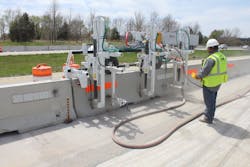Limit Worker Exposure When Placing Concrete Barriers
Concrete barrier placement is one of the most dangerous jobs for a highway crew. It’s often done within a limited space in close proximity to the very traffic the barriers are meant to channel, and it exposes workers to the possibility of struck-by-vehicle accidents.
One way to place barriers is the traditional craning method, in which a backhoe or excavator (or perhaps a wheel loader with a jib) hooks the barrier and puts it into place. But this usually requires workers on the ground to hook the load, help position it, and unhook the load. All the while, traffic is moving by, sometimes at high speeds.
In recognition of National Safety Month, here’s a brief look at a few of the products and precautions available to managers to limit the amount of workers involved in the process—and keep them out of danger.
Vacuum lifting system
One of the more interesting barrier lift attachments (also used for pipe and other heavy items) was designed with safety in mind. It uses vacuum technology to secure loads.
Vacuworx, Tulsa, Okla., says such technology is safer than the traditional method of having workers walk with the barrier to balance and position it, putting them in harm’s way.
The first Vacuworx unit, developed 16 years ago for pipe placement, came with its own diesel engine to power the vacuum process.
Last year, the company made a change from on-board diesel power to hydraulic power—allowing a direct connection to a machine’s hydraulic system. In essence, it behaves even more like an attachment.
The units attach directly to the boom of machines with dedicated auxiliary hammer circuits and can be used with or without a coupler system.
Operators of the excavator or backhoe use the attachment from the cab via a wireless remote control feature. Because the attachment has the ability to rotate 360 degrees, it can position barriers without guide workers on the ground.
The first attachments with hydraulic power are the MC5 (11,000-pound lift capacity) and the RC Series, which consists of four models (lift capacities from 22,000 to 44,000 pounds).
The HL Series is the company’s newest barrier lift system. It has elastomer grips, Vacuworx says, that provide full contact on a barrier. A hydraulic lock prevents the loss of the load if hydraulic pressure from the host machine happens to be lost.
Breaking capabilities down by model, the HL B1 can lift concrete barriers up to 12 feet long and 6,000 pounds, and the HL B2 can lift barriers up to 30 feet long and 16,000 pounds.
A shackle and alignment guides
Kenco, a company out of Ligonier, Pa., is another firm that produces a dedicated attachment for lifting and placing concrete barriers, but its method uses neither hydraulic hook-ups to machines nor diesel to help attach loads. Kenco barriers attach to the host machine with just a shackle.
The company has six models of barrier lifts, ranging from the 9,000-pound-capacity KL9000 (handles 10- to 16-foot Jersey walls) to the KL40000, which has a 40,000-pound capacity for 20- to 40-foot lengths of Jersey wall.
Kenco also has a special model, the KL12000TLP, designed to handle the Texas Low Profile Barrier Wall, a specification unique to Texas.
Safety comes into play with the company’s optional alignment guides, a product that attaches to one side of the lifter to allow a machine operator to lower the lifter onto the wall—eliminating the need for a ground assistant to perform the job. As the lifter is lowered, the extension of the legs on just one side glides the barrier lift into position.
Pin it down
Once the barrier has been placed, it must be secured, of course. A common method involves drilling holes through the pavement and attaching the barrier directly to and through the surface with pins.
Minnich Manufacturing, Ashland, Ohio, has developed a concrete barrier wall drill that places vertical holes into road surfaces for the pins used to secure the barriers. The unit is air-driven and self-propelled, traveling on rubber tires across the top of the barrier.
It’s notable because it keeps workers behind the barrier. It can also be moved manually (rolled) along the barrier by just one person.
Remotely operated via a tethered controller, the unit simultaneously drills three holes through pre-molded holes in the barrier, through the roadway and into the sub-base. The operator controls the unit from the non-traffic side of the barrier. This also places him or her away from the debris and dust of the drilling operation.
The drill can be customized for any barrier-wall profile, including F-shaped barriers and Jersey barriers. Drill spacing and depth are fully adjustable, the company points out.
About the Author
Frank Raczon
Raczon’s writing career spans nearly 25 years, including magazine publishing and public relations work with some of the industry’s major equipment manufacturers. He has won numerous awards in his career, including nods from the Construction Writers Association, the Association of Equipment Manufacturers, and BtoB magazine. He is responsible for the magazine's Buying Files.

